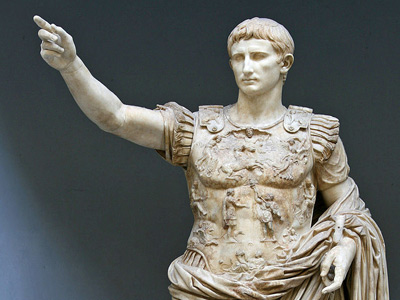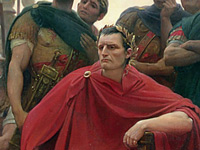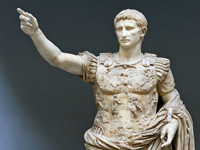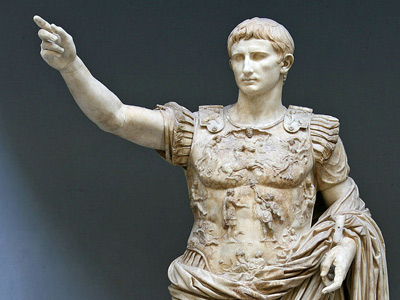Final War of the Roman Republic (32-30 BC)

Political and Military Buildup
Background
The Caesarians Octavian (Caesar's principal, though not sole, heir), Mark Antony, and Marcus Lepidus under the Second Triumvirate had stepped in to fill the power vacuum caused by Julius Caesar's Julius Caesar (100-44 BC), was a Roman politician and general who played a critical role in the events that led to the demise of the Roman Republic and the rise of the Roman Empire. Caesar is considered by many historians to be one of the greatest military commanders in history. Julius Caesar » assassination. After the Triumvirate had defeated Marcus Junius Brutus and Gaius Cassius Longinus at the Battle of Philippi (42 BC) and Lepidus was expelled from the Triumvirate (36 BC), Octavian and Antony were left as the two most powerful men in the Roman
Julius Caesar (100-44 BC), was a Roman politician and general who played a critical role in the events that led to the demise of the Roman Republic and the rise of the Roman Empire. Caesar is considered by many historians to be one of the greatest military commanders in history. Julius Caesar » assassination. After the Triumvirate had defeated Marcus Junius Brutus and Gaius Cassius Longinus at the Battle of Philippi (42 BC) and Lepidus was expelled from the Triumvirate (36 BC), Octavian and Antony were left as the two most powerful men in the Roman The Roman Republic was a form of government of Rome and the era of the classical Roman civilization when it was run through public representation of the Roman people. Beginning with the overthrow of the Roman Kingdom (traditionally dated to 509 BC) and ending in 27 BC with the establishment of the Roman Empire, Rome's control rapidly expanded during this period - from the city's immediate surroundings to hegemony over the entire Mediterranean world. world. Octavian took control of the west, including Hispania, Gaul, Italia, and Africa. Antony received control of the east, including Graecia, Asia, Syria and Aegyptus.
The Roman Republic was a form of government of Rome and the era of the classical Roman civilization when it was run through public representation of the Roman people. Beginning with the overthrow of the Roman Kingdom (traditionally dated to 509 BC) and ending in 27 BC with the establishment of the Roman Empire, Rome's control rapidly expanded during this period - from the city's immediate surroundings to hegemony over the entire Mediterranean world. world. Octavian took control of the west, including Hispania, Gaul, Italia, and Africa. Antony received control of the east, including Graecia, Asia, Syria and Aegyptus.
For a time, Rome saw peace. Octavian put down revolts in the west while Antony reorganized the east; however, the peace was short lived. Antony had been having an affair with the queen of Egypt, Cleopatra. Rome, especially Octavian, took note of Antony’s actions. Since 40 BC, Antony had been married to Octavia Minor, the sister of Octavian. Octavian seized the opportunity and had his minister Gaius Maecenas produce a propaganda campaign against Antony.
All of Rome felt astonished when they heard word of Antony’s Donations of Alexandria. In these donations, Antony ceded much of Rome’s territory in the east to Cleopatra. Cleopatra and Caesarion were crowned co-rulers of Egypt and Cyprus; Alexander Helios was crowned ruler of Armenia, Media, and Parthia; Cleopatra Selene II was crowned ruler of Cyrenaica and Libya; and Ptolemy Philadelphus was crowned ruler of Phoenicia, Syria, and Cilicia. Cleopatra took the title of Queen of Kings and Caesarion took the title of King of Kings.
In response, Octavian increased the personal attacks against Antony, but the Senate and people of Rome were not convinced. Octavian’s chance came when Antony married Cleopatra in 32 BC before he divorced Octavia. That action combined with information that Antony was planning to establish a second Senate in Alexandria created the perfect environment for Octavian to strip Antony of his power.
Octavian summoned the Senate and accused Antony of anti-Roman sentiments. Octavian had illegally seized Antony’s will from the Temple of Vesta. In it, Antony recognized Caesarion as Caesar's legal heir, left his possessions to his children by Cleopatra, and finally indicated his desire to be buried with Cleopatra in Alexandria instead of in Rome. The Senators were not moved by Caesarion or Antony’s children but Antony’s desire to be buried outside of Rome invoked the Senate’s rage. Octavian, the natural politician he was, blamed Cleopatra and not Antony. The Senate declared war on Cleopatra, and Octavian knew that Antony would come to her aid.
When Cleopatra received word that Rome had declared war, Antony threw his support to Egypt. Immediately, the Senate stripped Antony of all his official power and labeled him as an outlaw and a traitor. Octavian summoned all of his legions, numbered at almost 200,000 Roman legionaries. Cleopatra and Antony did the same, assembling roughly the same number in mixed heavy Roman and light Egyptian infantry.
HISTORY

RESOURCES
This article uses material from the Wikipedia article "Final War of the Roman Republic (32-30 BC)", which is released under the Creative Commons Attribution-Share-Alike License 3.0.
© Stories Preschool. All Rights Reserved.









